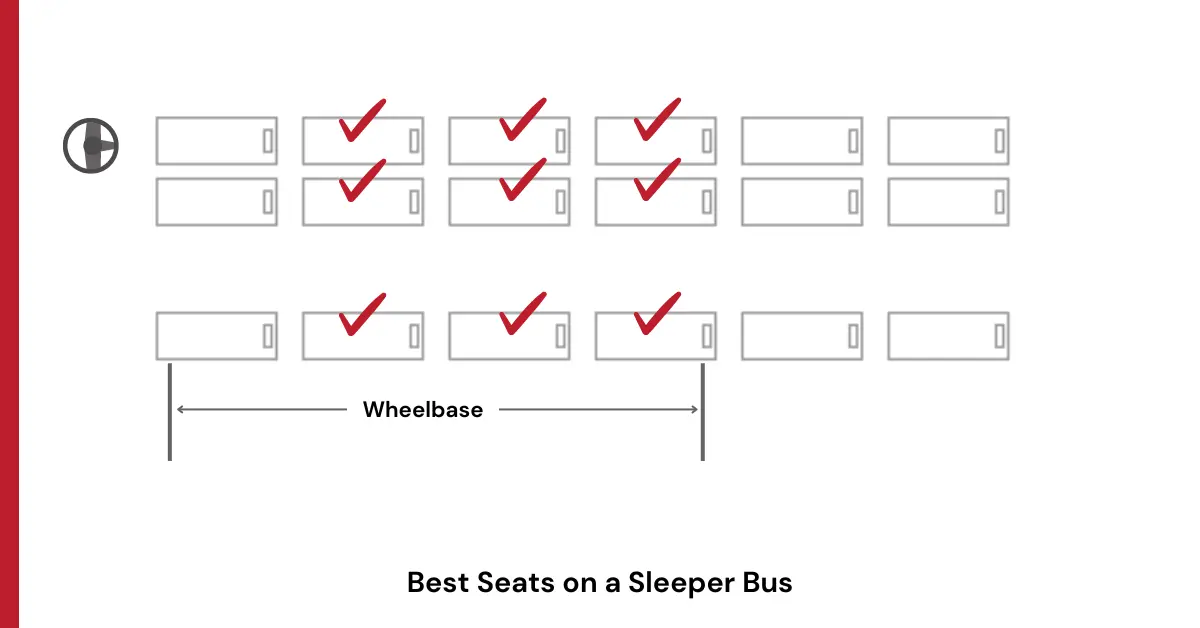Which is the best seat on a sleeper bus?
When finding the best seat on a sleeper bus in India, you should consider the upper berths as they stand out for their privacy and comfort. Additionally, for optimal comfort during the journey, aim for seats in the second or third compartment, as they are less affected by bumps and jerking, being within the wheelbase.

Sleeper buses offer travelers in India a convenient mode of transportation renowned for comfort, affordability, and accessibility even for last-minute bookings.
However, selecting the best seat on a sleeper bus is indispensable if you want a comfortable journey.
This article provides insights into identifying the most suitable seats in a sleeper bus and the rationale behind their selection.
Read More: Everything you need to know about Sleeper Buses in India
The Best Seat on a Sleeper Bus

For optimal comfort and safety, opt for a seat in the middle section of the bus, preferably in the second or third compartment.
Being within the wheelbase, these areas experience minimal impact from bumps and jerks, ensuring a smoother ride.
Additionally, in the unfortunate event of an accident, seats in the middle rows are strategically positioned to minimize potential damage, as they are equidistant from the front and rear of the bus.
Upper vs Lower Berth: Making the Right Choice
The perennial debate between upper vs lower berths has long dominated discussions on the best seats in a sleeper bus.
However, to be honest, the choice between the lower and upper berth hinges on personal preferences, each offering its own set of advantages and drawbacks.
You may consider the following to make an informed decision:
Advantages of the upper berth:
- Enhanced privacy: Positioned higher and away from the aisle, the upper berth provides greater privacy.
- Reduced noise: Typically quieter than the lower berth, as it’s further from engine and road sounds.
Advantages of the lower berth:
- Easier accessibility: Being closer to the ground, the lower berth is more easily accessible, making it convenient for passengers.
- Convenient entry and exit: Passengers can get in and out of the lower berth with greater ease, especially for those with mobility concerns.
- Stability: Generally experiencing less movement compared to the upper berth, the lower berth offers a more stable journey experience.
Passenger Seat Preferences in Sleeper Buses

To gain practical insights into passenger preferences, we interviewed 80 sleeper bus passengers.
Surprisingly, 75% of the respondents favored the upper berths.
Those opting for lower berths cited concerns such as overweight or mobility issues as their reasons for choosing the lower berth.
“I prefer upper berths in the second or third compartment for the privacy they offer. Additionally, I always choose buses with shutters instead of curtains. For solo female travelers, selecting a single upper berth is advisable,” Punam Agarwal, who frequently travels between Delhi and Lucknow.
Wrapping it Up
For optimal comfort and safety during the journey, seats in the second or third compartment are recommended, as they are less affected by bumps and jerks.
Additionally, insights from passenger preferences highlight a predominant inclination towards upper berths for enhanced privacy, with considerations such as shutter-equipped buses being favored for added convenience.
Ultimately, understanding these nuances empowers travelers to make informed decisions and enjoy a comfortable journey aboard sleeper buses.
So, whether it’s the upper or lower berth, the key is to choose the seat that aligns best with your preferences and requirements.
Catch the latest Bus Industry updates, Exclusive Interviews, Bus News, and International Bus News on Coach Builders India. Download the latest issue of the The Bus Insider magazine for more insights.







